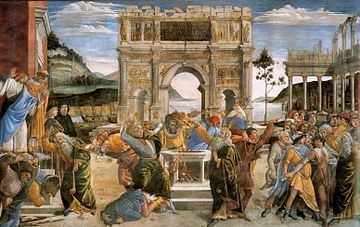Year 1480–1482 Artist Sandro Botticelli Created 1480–1482 Genre Christian art | Type Fresco Location Sistine Chapel Period Early renaissance | |
 | ||
Dimensions 348.5 cm × 570 cm (137.2 in × 220 in) Similar Sandro Botticelli artwork, Artwork at Sistine Chapel, Fresco | ||
Punishment of the rebels
The Punishment of the Rebels is a fresco by the Italian Renaissance painter Sandro Botticelli, executed in 1480–1482 and located in the Sistine Chapel, Rome.
Contents
History
On 27 October 1480 Botticelli, together with other Florentine painters, left for Rome, where he had been called as part of the reconciliation project between Lorenzo de' Medici, the de facto ruler of Florence, and Pope Sixtus IV. The Florentines started to work in the Sistine Chapel as early as the Spring of 1481, along with Pietro Perugino, who was already there.
The theme of the decoration was a parallel between the Stories of Moses and those of Christ, as a sign of continuity between the Old and the New Testament. A continuity also between the divine law of the Tables and the message of Jesus, who, in turn, chose Peter (the first bishop of Rome) as his successor: this would finally result in a legitimation of the latter's successors, the popes of Rome.
Botticelli, helped by numerous assistants, painted three scenes. On 17 February 1482 his contract was renovated, including the other scenes to complete the chapel's decoration. However, on the 20th of the same month, his father died: he returned to Florence, where he remained.
Description
The painting depicts three episodes and tells of a rebellion by the Hebrews against Moses and Aaron. On the right the rebels attempt to stone Moses after becoming disenchanted by their trials on their emigration from Egypt. Joshua has placed himself between the rebels and Moses, protecting him from the stoning. The center scene shows the rebellion with Korah and the conspirators being driven out by Moses and Aaron, as high priest wearing the papal diadem. To the left, the ground opens and the two principal conspirators sink into it. The children of Korah are spared the fate of their father.
The intended message of the painting is clear, no one should doubt the authority of the Pope over the Church. The power of the papacy was constantly being questioned at the time.
